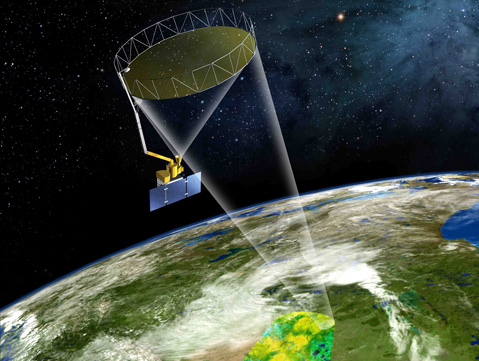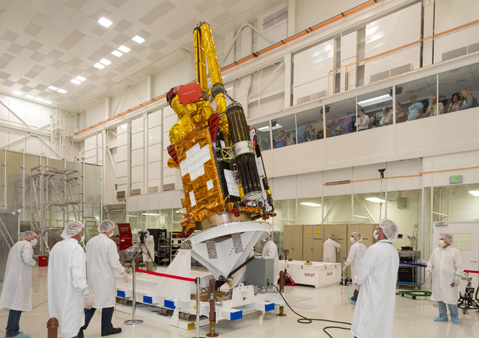S.B. Scientists Make It SMAPpy
Vandenberg Launching NASA Satellite Fitted with South Coast Hardware

Earth’s biggest “lasso” built by South Coast engineers is blasting into space Thursday aboard a NASA satellite that will measure soil moisture from hundreds of miles in the air. The 18-foot circular antenna — made of hair-thin, gold-plated wire knitted together like a nylon stocking that will unfurl in orbit — is designed to spin around an elbowed “arm” and act as a reflector to transmit microwaves toward the surface of the planet and grab the signals that bounce back.
The Soil Moisture Active Passive (SMAP) satellite can detect water two inches below the surface, which will help predict floods and droughts, inform farmers when and where to plant, create better climate models, and track disease spread by pinpointing mosquito breeding grounds. High-resolution imagery will map the entire globe every two to three days. The SMAP mission launching from Vandenberg Air Force Base joins 18 other satellites that track what scientists calls “Earth’s vital signs.” From development to launch to its three-year lifespan, the project will cost around $916 million, according to NASA.

Carpinteria-based Astro Aerospace provided the SMAP’s radar reflector. The company, a business unit of Northrop Grumman with a manufacturing plant in Goleta, has supplied hardware to hundreds of space missions since 1958 and is batting 1.000 during tricky and high-stakes deployments. The company’s products have gone to Mars, around Earth, and beyond, said business manager Ed Keay. The mesh dish will unfurl about 20 days after the SMAP launch and will spin up a couple weeks later, he explained.
With 75 employees — many of them UCSB and Cal Poly graduates — Astro Aerospace is also now working on a sci-fi-sounding NASA mission called Starshade. The company’s patented AstroMesh technology will be used to make large “sunflower” petals to block the light from distant stars so telescopes can better view Earth-like planets in other solar systems.


